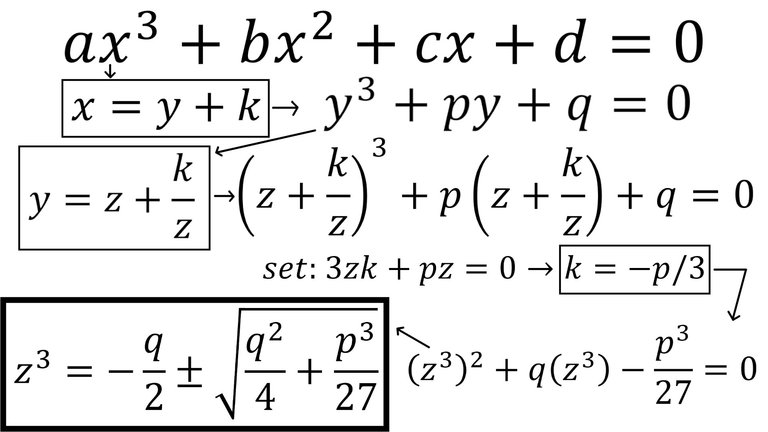In this video I go over the second step in deriving the Cubic Formula, and this involves converting our earlier PQ version of the cubic formula into a quadratic formula using Vieta's substitution. In step 1 we converted x into y by the equation x = y + k. In step 2 we convert y into z by the equation y = z + k/z. Then we do the exact same procedure as before to select a k value that cancels out the z1 terms. Then, multiplying by z3 we obtain a quadratic equation, which we can solve using the PQ version of the quadratic formula. In later steps, we will convert z back into y and then finally back into x.

Timestamps
- Step 2: Solve PQ Cubic Equation using Vieta's substitution to obtain quadratic formula: 0:00
- Let y = z + k/z: 0:57
- Select k to cancel out z terms: 3:07
- k = -P/3: 4:13
- Convert resulting equation into a quadratic equation by multiplying by z3: 6:54
- Recall PQ version of the Quadratic Formula: 7:54
- Apply the PQ quadratic formula to our equation: 9:51
- Solution for z3: 10:58
Notes and playlists
- Summary:
- Playlist: https://www.youtube.com/playlist?list=PLai3U8-WIK0EF05ExjzLbB64NgUjoV1hl
- Notes: https://peakd.com/hive-128780/@mes/dzekfnxh .
Become a MES Super Fan! https://www.youtube.com/channel/UCUUBq1GPBvvGNz7dpgO14Ow/join
DONATE! ʕ •ᴥ•ʔ https://mes.fm/donate
SUBSCRIBE via EMAIL: https://mes.fm/subscribe
MES Links: https://mes.fm/links
MES Truth: https://mes.fm/truth
Official Website: https://MES.fm
Hive: https://peakd.com/@mes
Email me: [email protected]
Free Calculators: https://mes.fm/calculators
BMI Calculator: https://bmicalculator.mes.fm
Grade Calculator: https://gradecalculator.mes.fm
Mortgage Calculator: https://mortgagecalculator.mes.fm
Percentage Calculator: https://percentagecalculator.mes.fm
Free Online Tools: https://mes.fm/tools
iPhone and Android Apps: https://mes.fm/mobile-apps
▶️ 3Speak
!summarize
Congratulations @mes! You have completed the following achievement on the Hive blockchain And have been rewarded with New badge(s)
Your next target is to reach 5750 replies.
You can view your badges on your board and compare yourself to others in the Ranking
If you no longer want to receive notifications, reply to this comment with the word
STOPCheck out our last posts: